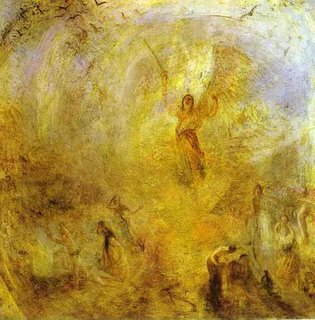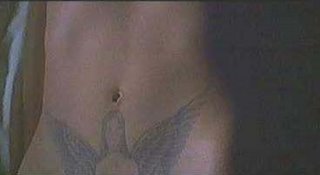
(JMW Turner; The Angel, Standing in the Sun; 1846)

"There is a painting by Klee called Angelus Novus. It shows an angel who seems about to move away from something he stares at. His eyes are wide, his mouth is open, his wings are spread. This is how the angel of history must look. His face is turned toward the past. Where a chain of events appears before us, he sees on single catastrophe, which keeps piling wreckage upon wreckage and hurls it at his feet. The angel would like to stay, awaken the dead, and make whole what has been smashed. But a storm is blowing from Paradise and has got caught in his wings; it is so strong that the angel can no longer close them. This storm drives him irresistibly into the future to which his back is turned, while the pile of debris before him grows toward the sky. What we call progress is this storm."
--Walter Benjamin.

(The midriff of the esteemed Asia Argento in New Rose Hotel, 1998.)
For a moment I wonder if the 'angel,' having been so thoroughly understood in modernity for its symbolic functions (and hardly as a literal messenger or psychopomp) slowly became aligned with material things. Out of Turner (and the early modernism) we've got an angel coming from the ether into materiality (i.e., paint), though I admit I've done no research on that count as far as Turner's art is concerned. Pure speculation here. Approaching materiality, the angel is caught up in history (Benjamin). Eventually the angel appears as the emblem of history, tattooed on the body of an actress in a cheap under-the-radar film masterpiece. New Rose Hotel posits X (Willem Defoe) as a witness to History, but he thinks it's the mastery of his friend Fox (Christopher Walken), and he thinks he's privy to this mastery. Sandii (Argento), the 'Eurasian' love interest, the Angel, is no longer buffeted about by the storm of progress--the angel has been enlisted in its service. X realizes that, finally, he's the one buffeted about; the Angel stands as a figurative banner-holder for progress that threatens to override a dispersing, decaying empire ...
A reasoned historical argument? No.
A question to keep in mind for a major trope in Western art? I'd like to think so ...

No comments:
Post a Comment